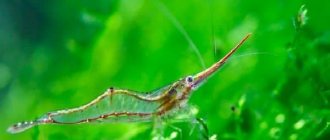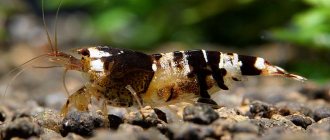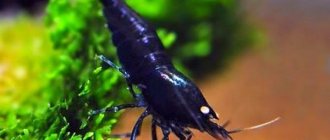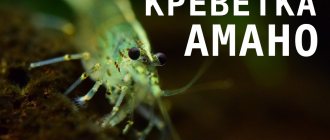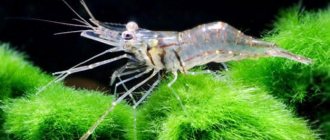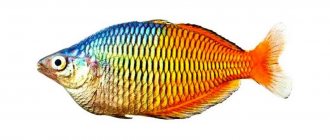Home › Aquarium shrimp ›
( 3 ratings, average: 5.00 out of 5)
Freshwater aquarium shrimp have never been as popular as they are today. And the most popular among amateur aquarists, accessible and widespread, are dwarf freshwater shrimp of the genus Neocaridina. Freshwater neocaridina shrimp include such popular varieties as red cherry shrimp (Neocaridina heteropoda var 'red'), snowflake shrimp (Neocaridina cf. zhangjiajiensis var 'white'), blue pearl shrimp (Neocaridina cf. zhangjiajiensis var 'blue'), yellow shrimp ( Neocaridina heteropoda var 'yellow') and many others.
The best aquarium shrimp for beginners belong to the Neocaridina genus, such as the red cherry. However, most neocaridina shrimp are quite hardy and relatively easy to keep.
Where do neocaridins come from?
Wild neocaridine shrimp are native to Southeast Asia and live in rivers and ponds densely overgrown with plants, sunken tree branches and rocks. However, all the colored varieties that you will find on sale were bred in captivity by breeders. If you come across a shrimp called neocaridina Neocaridina heteropoda on sale, then most likely it will be a colorless shrimp or somewhat colored in one of the colors, but grown at home - you are unlikely to find wild shrimp caught in the wild.
Homeland of shrimp
In nature, this species of arthropod is found in shallow freshwater bodies of China and Taiwan. The bottom of such reservoirs consists of silty sediments and fine sand, and the flow of water is almost imperceptible.
Despite this, shrimp prefer to live in clean water with a high oxygen content. The bodies of wild shrimp are not brightly colored; they are almost transparent in order to blend in with the environment as much as possible.
Females are usually slightly larger than males and more brightly colored. In nature, it is difficult to distinguish the sex of a small shrimp; in addition to size, the shape of the tail is also different. The male has a straight underbelly, while the female has a wide and convex abdomen, created for carrying eggs.
Wild Neocardina shrimp live in small schools, quickly scattering in case of danger.
What should an aquarium be like for neocaridina?
Neocaridina is best kept in an aquarium that is densely planted with live aquarium plants, with plenty of hiding places and mosses. Aquariums with driftwood, roots and rocks are also great. Plants and natural scenery provide shrimp with shelter, and bacteria, algae and other microscopic organisms develop on their surfaces - the best natural food for aquarium shrimp, which makes up the majority of their diet.
Shrimp do not school like fish, but it is better to keep them in groups - this way they will feel more comfortable and will not be shy. A larger group also increases the gene pool.
Compatible with fish and other shrimp
Cherry itself is completely harmless. She does not attack other residents of the aquarium. However, these shrimp can be eaten or maimed by many fish. Ideally, keep shrimp completely separate. But if this is not possible, you should choose small, peaceful fish as neighbors. These can be Rasbora, Red or Blue Neon, Otocinclus, Dwarf Gourami. Larger and more aggressive fish are capable of completely destroying the entire population of shrimp, for example, angelfish.
If you are not sure whether the fish will get along with Cherry, you can focus on their size: the larger it is, the higher the likelihood that the shrimp will be hunted.
Sometimes you can notice that several Cherries are eating fish, but this does not mean at all that they have carried out an attack: they are simply feasting on someone who has died on their own (as they clean the aquarium by eating something continuously).
Even if the fish living in the neighborhood do not attack adult Cherries, it will be more difficult for the babies to survive. Therefore, it is necessary to provide safe areas for them.
What is the minimum size of the aquarium?
Neocaridina shrimp are very small and have little impact on the biological load of the aquarium, especially if kept in a community aquarium rather than in a shrimp tank. However, if you have a species aquarium (the so-called shrimp tank), then the population will increase quickly, the shrimp will need additional feeding and this must be taken into account.
Still, shrimp can be kept in small aquariums, so-called nano aquariums with a volume of up to 15 liters, provided that there are live plants and filtration. But aquariums of such small sizes are not the best choice even for neocaridina shrimp, because even if you have 6 shrimp living in 10 liters, within a very short period of time (up to six months) the population can increase to 100 shrimp!
Therefore, the principle of choosing the volume of an aquarium for shrimp is the same as for fish - the larger the better. Use the largest aquarium you can afford and have room for in your home. The larger the volume, the more stable the water parameters and temperature will be, which means it is safer. One of the most common factors for the death of shrimp is a sharp increase in temperature, a change in water quality, and nano aquariums are more prone to such problems.
Feeding the Blue Dreamy shrimp
Blue dream shrimp photo
Feeding blue dream shrimp is very easy, as they are omnivores and will accept virtually any type of food made for shrimp or fish: blanched spinach, zucchini, seaweed, shrimp pellets, fish flakes, bloodworms and much more. It is worth paying attention to the feeding time interval, which is a good indicator of health.
It is better to feed once a day. The amount of food required for shrimp should be consumed within a maximum of 2-3 hours. Excess feed is bad for shrimp. Overfeeding can lead to their death and also affect the quality of water in the aquarium. Remember that shrimp are waste collectors. They eat whatever they find 24 hours a day, 7 days a week.
Blue dream shrimp photo
Feeding any aquarium fish and shrimp must be correct: balanced, varied. This fundamental rule is the key to successful content. The article “ How and how much to feed aquarium fish ” talks about this in detail; it outlines the basic principles of the diet and feeding regime of the fish.
Remember that feeding fish and shrimp should not be monotonous; the diet should include both dry food and live food: protein and vegetable.
Popular and popular food for fish, shrimp and crustaceans, of course, are dry food. For example, you can constantly and everywhere find food from Tetra, the leader of the Russian market, on aquarium shelves. In fact, the range of food from this Tetra is included as individual food for a specific type of fish: for small ornamental fish (Tetra Micro Food), for goldfish, for cichlids , for loricariids, guppies, labyrinths, arawans, discus, etc. Tetra has also developed specialized foods, for example, to enhance color, fortified, or for feeding fry. For shrimp and crustaceans, the Tetra line includes the complete food Tetra Crusta. You can find out detailed information about all Tetra foods on the company's official website - here .
It should be noted that when purchasing any dry food, you should pay attention to the date of its manufacture and shelf life, try not to buy food in bulk, and also store the food in a closed state - this will help to avoid the development of pathogenic flora in it.
What water conditions are needed?
Dwarf freshwater shrimp require high quality water. Even a tiny trace of ammonia will be fatal, and these animals are intolerant of nitrites. The best place to keep shrimp is an aquarium with an established full nitrogen cycle.
Excess copper in water will also lead to death. If you purchase new plants, wash them thoroughly - they may have been treated with preparations containing copper. This also applies to snails. However, traces of copper can be present in any aquarium through plant fertilizers, food, water and other sources. As a rule, this does not lead to dire consequences. If you are unsure about your tap water, do tests.
In fact, shrimp need microscopic doses of copper to transport oxygen in the blood, just as humans need iron.
Most neocaridine species do better in hard water with a pH of 6.5-8.0. If the water is too soft, then it is necessary to additionally add calcium to the water, which is needed for the formation of a new shell after molting.
Most shrimp tolerate water temperatures between 18 °C and 28 °C. Neocaridins can withstand both lower and higher temperatures, but for a short period of time. The optimal water temperature is 21-26 ° C.
At higher temperatures, shrimp growth and reproduction accelerates, however, life expectancy is reduced due to accelerated metabolism. Also, when kept in warmer water, aeration of the water may be required due to lack of oxygen.
Description
This is a small shrimp, rare specimens grow up to 4 cm in size, usually they are smaller. They live for about a year, but given that there are usually several dozen cherries in an aquarium, it is difficult to estimate accurately.
The color itself is indicated by the name - cherry, they look especially bright in an aquarium against a background of greenery, for example, dark Java moss. It’s hard to say about any specific features; the cherries are miniature and you can’t really see anything special.
How long do they live? Life expectancy is short, about a year. But usually during this time they manage to bring a lot of babies.
Who is a suitable aquarium neighbor for shrimp?
The best tank neighbors for shrimp are snails and other dwarf shrimp. If you want to regularly see your shrimp, observe their natural behavior, such as swimming near the surface of the water near floating plants and in the water column, then it is better to have a species-specific aquarium - a shrimp tank.
If you still decide to keep shrimp with aquarium fish, then choose those that are too small to feed on them, algae eaters or fry. Fish such as Otocinclus affinis are 100% vegetarian and will not eat shrimp, even newborns. Other catfish, such as corydoras or ringed catfish, are safe, but to a lesser extent.
It is possible to keep them with laliuses, small species of tetras, microrasboras, and loaches, but only in aquariums densely planted with live plants, where the shrimp can hide.
And keep in mind that if kept with the same otocinclus, you will need a much larger aquarium, preferably 100 liters or more.
The difference between a male and a female
Even an amateur can quickly learn to notice these differences: females are larger and brighter, their bellies are slightly curved. The tail of females is wider, it protects the eggs. Whereas in males it is long and narrow. In addition, in females, a special “saddle” is formed behind the head, which is light in color. The "saddle" is released as the female becomes sexually mature. This word refers to eggs that mature in the ovaries.
If everything is in order with the shrimp population, the females will almost continuously carry eggs (located behind the hind legs under the tail) - then it is no longer possible to confuse them.
Is the aquarium filter sucking up shrimp?
This is a common problem with both external and internal filters, especially for children. And yet the problem can be easily solved by blocking the suction hole with nylon and securing it with an elastic band. You can also adjust the filter power by reducing the flow to a minimum.
If you have an external filter, shrimp may often get sucked into it, but this is not a problem. You will be able to find your shrimp happily existing in the filter, feeding on the bacteria.
Still, the best filter for a shrimp aquarium is an internal canister or airlift filter with sponge filter material.
Unwanted crossbreeding
Bright, beautiful species of Neocardina shrimp were bred through long selection. Sometimes an inexperienced breeder thinks that by placing several types of shrimp in an aquarium, he will get a new unique species.
But with shrimps everything is more complicated; when different species are crossed, the offspring do not inherit the best traits of the parents. On the contrary, with interspecific crossing, the offspring turns out gray and nondescript. For example, if you bring White Snowflake and Cherry together, you will not get a delicate pink shrimp, but a hybrid of a gray, unattractive color.
How do neocaridins reproduce?
No special conditions are required for the propagation of neocaridine aquarium shrimp. If the shrimp are alive and healthy, they will reproduce.
Neocaridina usually spawns eggs soon after molting. The female releases pheromones into the water to inform the males that she is ready for fertilization. It is usually easy to identify such a female by the pronounced “saddle” - a yellow spot on the back, which represents unfertilized eggs. Only in some species of neocaridines is it difficult to see the “saddle” due to the rich color.
The male fertilizes the female through close contact, releasing sperm into her genital opening. As the eggs pass through this opening, they are fertilized and drop down the female's abdomen near her swimming legs (pleopods), where the female carries the eggs until the young are born.
This period lasts 3-4 weeks.
Types of shrimp
Over the years of selection, about a dozen ornamental species of Neocardina shrimp have been bred from a single wild ancestor. In these multi-colored bright creatures one can hardly see the signs of an imperceptible transparent great-great-grandmother.
Freshwater shrimp Neocaridina are classified according to color. The most common species in home aquariums are:
- Red cherry or cherry. The most unpretentious and popular type. He loves plants and mosses very much, in which the offspring will hide.
- Yellow Pearl or Canary. It has a rich yellow color that turns orange with age.
- White Pearl or Snowflake. An almost transparent, whitish creature that seems to be a guest from another world. But it is not difficult to distinguish a male from a female, whose snow-white eggs are visible through the transparent body.
- Blue or Blue Dream. This deep blue shrimp will brighten up any aquarium. However, the blue gene is not yet sufficiently fixed and the offspring of such shrimp may be greenish or even transparent.
- Chocolate Neocaridina Heteropoda. It appeared in our country relatively recently. It is distinguished by a rich brown tint with a reddish tint.
The maximum size of these shrimp does not exceed 3 cm. According to reviews of keeping Neocardina shrimp in an aquarium, with good care, pets can live up to two years.
How to raise offspring?
Aquarium neocaridine shrimp do not show parental care and their children are very vulnerable, being only about a millimeter in length. If shrimp are kept with fish, it is very important to provide them with mosses and other shelters where the children can hide and feed.
The offspring should be kept in a mature aquarium. A new aquarium contains too few microorganisms necessary to feed young shrimp. This is why offspring often die in a new aquarium. As the shrimp grow, they will eat particles of shrimp food and algae.
Water quality and temperature are also important.
Number control
If food and partners are available, shrimp will reproduce very quickly. Babies just born look like transparent copies of their parents. But they grow quickly and after ten months they will also begin to look for a partner to mate with.
Surprisingly, the shrimp population itself regulates its numbers: when the aquarium is very densely populated, the males protect their part of the territory from the young and there is no time left for mating. Young shrimp almost stop appearing. Gradually the quantity decreases, the shrimp begin to actively reproduce again and the circle closes. This can be regulated by periodically looking for a new home for young shrimp.
Appearance
If we judge the color typical for a given species, it can be noted that it is quite variable, and it can depend on a huge number of different factors. In particular, the power and spectrum of light, feeding, shelter in the form of plants or lack thereof, temperature, age of individuals, potential threat, and much more have their influence. The color of the environment also has an impact on the condition of the shrimp.
Red Cherry Shrimp (Neocaridina denticulata sinensis)
So, they are very bright against the background of dark soil. Sometimes it seems that the color even depends on the current mood of the individual. You shouldn’t be surprised by these features of theirs - the pigment cells of these crustaceans can both shrink and expand, and therefore a color change can be achieved almost instantly. And, you can notice that when a suitable fish appears in the aquarium - for example, guppies, the color of the animals intensifies. In some populations, males and females may be equally brightly colored. If you want to achieve bright colors in the shrimp population, then you need to select. After transportation, you may notice a decrease in the color intensity of the shrimp. They may even shed.
Cherries and seaweed
There is a lot of debate on the topic of the destruction of algae by cherries - thread grass, beard. And you can hear opposing opinions. As I observed myself, cherries are capable of eating algae, but they do it extremely reluctantly. But with all this, I noticed that some time after the shrimp appeared in the aquarium, the filament, which I had been struggling with for literally years, simply disappeared. At all! My shrimp get excellent nutrition, no one starves them. I can guess the following. Probably, the harmful algae disappeared not because the cherries ate them, but because, for normal growth, they, among other things, need rest, as complete as possible. When they are disturbed, they don't like it. Shrimps rush over them constantly, and, in fact, simply trample down the weed. In the same way, if you let chickens into the garden, they will simply compact it in a week, and not a single blade of grass will remain. Or how football players can trample a football field if it is not maintained.
But on the other hand, many of the aquarists who received cherries from me say that in their aquariums the shrimp feed on algae. This cannot be denied either.
Reviews of freshwater shrimp
Andrey, review of freshwater cherry red shrimp
Small, funny, able to move quickly in case of danger, they live in an aquarium with ordinary neons, black neons, rhodostomus (red-nosed tetra) and a pair of tri-colored platies. They prefer dense thickets - Java moss and a huge amount of anubias. They eat everything, preferring substandard materials in the form of bottom sediments and growths, fallen plant leaves. They complement the artificial biotope and underwater picture well.
It can be recommended, especially if there is an external filter of a redundant configuration with a microporous inorganic filler, because This species reproduces quickly and will require a margin of safety in the ecosystem.
Svetlana, review of cherry red shrimp
If they are really purebred, not second hand, then they are very bright and beautiful! I bought tens of them secondhand. They are so pale! I arrived at the retail store of this site and could not leave without new cherries. In these you can read the absolute breed. They are not pink or speckled in places. It’s impossible to take his eyes off his completely scarlet eyes!
They do not combine with dwarf orange crayfish, although their compatibility is indicated here. Crayfish pop them like seeds! I bought 40 shrimp from my own hands and 7 from this store. I used to have them everywhere! Now I see it only sometimes. Several times I saw my crayfish eating cherry beauties :(. I stopped eating food for crayfish. Apparently, live ones taste better, now he runs around the aqua for shrimp all the time.
In general, the animals are cool. But, they say, they are very prolific! Just worse than cockroaches. Or a new subspecies of calorada. But I didn’t have time. Although I already bought several pieces for pregnant women.
Olga_K, review of Amano shrimp
You won’t surprise anyone with fish, but shrimp are an aquarium miracle. Everyone likes it! The advantages of amankas are that they grow large - up to 5 cm, that is, they can be added to a wide variety of fish, and not just to microfish. But, of course, you can’t put them with big, angry fish like cichlids, goldfish, mastacembalus, large barbs or loaches.
When amano grow up, they are always visible and interesting to watch. These are the most cunning and agile shrimps - they steal the largest pieces of food from under the noses of the fish. At the same time, amano are peaceful scavenger shrimps; they do not harm anyone.
Disadvantages: In their youth they are small and shy, and can get lost in a large aquarium. As a result, you are always nervous - are they alive? The composition of the water is also important for shrimp - you need to make sure that ammonia and nitrites are at zero, otherwise the shrimp may go to another world. The aquarium should have lush thickets - these are shelters for molting shrimp.
I bought three babies from Aqua-Logo to see if the shrimp would take root. They took root, but I rarely saw them. They were hiding. Then I bought them additional 5 cm adult females for company. Now they all run around the 180 liter aquarium together, and when it’s time for dinner, they all run out to the feeder and steal the bottom chips from the fish. Many of the fish I have are smaller than amano shrimp, so they have nothing to fear. The largest fish, the veiled male ramirezi, does not react to shrimp; they even steal its eggs.
They are excellent at cleaning plants from filamentous plants - when I bought amano and rednose shrimp, the filamentous shrimp stopped mowing in a visible place, it disappeared.
Andrey, review of Riley shrimp
Beautiful, very fast, corresponds to the picture. The main disadvantage is the preservation of appearance during reproduction. At 80%-90% reproduction, new shrimp will be either transparent or red.
Behavior
Cherry shrimp are completely harmless, and if you see them eating a fish, then this is the result of natural death, and the shrimp only eat the corpse. They are active throughout the day and can be seen moving around plants and decor in search of food.
Cherry shrimp regularly molt, and the empty shell lies on the bottom or even floats in the water. There is no need to be afraid, molting is a natural process, as the shrimp grows and its chitinous suit becomes tight. You don’t have to remove it; the shrimp will eat it to replenish their supply of substances.
The only thing is that during molting they need to hide, here moss or other plants come in very handy.
Is it possible to keep cherries together with fish?
Yes, you can, if the fish is small and peaceful. With this proximity, the shrimp feel quite comfortable, but you must be prepared for the fact that some of the newborn shrimp will be used as food for the fish.
In my aquarium, cherry shrimp live together with thorns, cardinals and other small fish, but for crustaceans there is a special corner fenced off with winding driftwood, filled with small twisted shells and abundantly planted with mosses and ferns. Fish hardly interfere in these wilds, and the cherries live and reproduce quietly.
